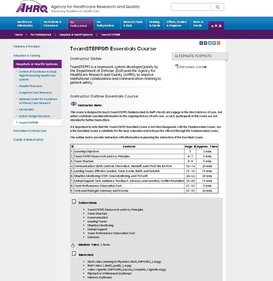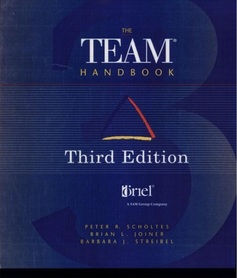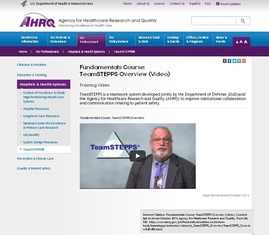Dr. Patterson from the School of Medicine reports on the progress with the Clinical Safety & Effectiveness course, project-based learning in quality improvement and patient safety for healthcare faculty and staff. Dr. Stevens from the School of Nursing reports on her progress with TeamSTEPPS (Strategies to Enhance Performance and Patient Safety)® training at our institution.
impact
|
Established a Clinical Safety and Effectiveness course and 2-day workshop serving 38 clinicians and faculty per year. |
Implemented the AHRQ TeamSTEPPS program, a teamwork system that offers a powerful solution to improving collaboration and communication within your institution. |
APTR project proposal for 2007/2008 ipe institute
|
We instituted an interprofessional course in HIV that had an experiential base in the University Health System HIV clinic, and interprofessional students completed a community service learning project that served the HIV community.
|
Sustained the post-institute IPE activity or project after the initial year of implementation: No, but alternative IPE programs were developed soon after |
current ipe activity/project description
The Clinical Safety & Effectiveness (CSE) course is directed by Dr. Jan Patterson in the School of Medicine. It is an interprofessional course for faculty and staff and is supported by University of Texas System Office of Health Affairs, the Dean of the School of Medicine, the UT Medicine ambulatory practice, and our clinical affiliate, University Health System (UHS). Participants of the course, including physicians, nurses, pharmacists, administrators, technologists, and others participate in quality improvement project-based learning to become competent in quality and patient safety concepts and skills. The TeamSTEPPS program is directed by Dr. Kathleen Stevens in the School of Nursing and is integrated with our clinical affiliate University Health System. It is supported by the School of Nursing and UT System and other grants.
Structural Dimension:
For the TeamSTEPPS portion of this project, structural dimensions recommended by AHRQ were used: the theoretical framework is embedded in the change management work from John Kotter (Our Iceberg is Melting); the program assessment is framed by the Kirkpatrick model; the measures included readiness, acceptance of the workshop; change in team values; change in team functioning perception, and implementation of TeamSTEPPS principles through quality improvement activities following the workshop. The curricular competencies are outlined in the standardized curriculum found at http://www.ahrq.gov/professionals/education/curriculum-tools/teamstepps/instructor/index.html Logistics of providing a 2-day workshop followed a checklist of event planning developed over a number of years workshop planning experience.
For the CSE course, we used improvement science principles, project-based learning, and return-on-investment calculations for experiential learning and sustainment. The CSE course curriculum includes quality and safety concepts such as: evidence-based medicine, understanding variation, QI theory and tools, quality metrics, data management, teamwork, human factors engineering, and statistical process control. Plan-Do-Study-Act (PDSA) is the QI methodology emphasized. Lean methodologies are also taught. http://uthscsa.edu/cpshp
For the TeamSTEPPS portion of this project, structural dimensions recommended by AHRQ were used: the theoretical framework is embedded in the change management work from John Kotter (Our Iceberg is Melting); the program assessment is framed by the Kirkpatrick model; the measures included readiness, acceptance of the workshop; change in team values; change in team functioning perception, and implementation of TeamSTEPPS principles through quality improvement activities following the workshop. The curricular competencies are outlined in the standardized curriculum found at http://www.ahrq.gov/professionals/education/curriculum-tools/teamstepps/instructor/index.html Logistics of providing a 2-day workshop followed a checklist of event planning developed over a number of years workshop planning experience.
For the CSE course, we used improvement science principles, project-based learning, and return-on-investment calculations for experiential learning and sustainment. The CSE course curriculum includes quality and safety concepts such as: evidence-based medicine, understanding variation, QI theory and tools, quality metrics, data management, teamwork, human factors engineering, and statistical process control. Plan-Do-Study-Act (PDSA) is the QI methodology emphasized. Lean methodologies are also taught. http://uthscsa.edu/cpshp
Human Dimensions:
TeamSTEPPS Certification opportunities were offered twice in the past year, free of charge to all faculty in UTHSCSA. Faculty list TeamSTEPPS Master Certification on their CVs. The CSE course was offered twice in the year, and was free for UTHSCSA faculty and staff, and for UHS staff. In 2015-16, 80 participants completed quality improvement projects with interprofessional teams including physicians, nurses, pharmacists, administrators, technologists and others.
TeamSTEPPS Certification opportunities were offered twice in the past year, free of charge to all faculty in UTHSCSA. Faculty list TeamSTEPPS Master Certification on their CVs. The CSE course was offered twice in the year, and was free for UTHSCSA faculty and staff, and for UHS staff. In 2015-16, 80 participants completed quality improvement projects with interprofessional teams including physicians, nurses, pharmacists, administrators, technologists and others.
Political Dimensions:
TeamSTEPPS was proposed as part of the IPE proposal for the SACS QEP accreditation. The CSE course was also used as an example of the importance of interprofessional work in discussion for the IPE QEP project. The value of IPE was emphasized in the course, since interprofessional teamwork is key in improving quality and safety in healthcare.
TeamSTEPPS was proposed as part of the IPE proposal for the SACS QEP accreditation. The CSE course was also used as an example of the importance of interprofessional work in discussion for the IPE QEP project. The value of IPE was emphasized in the course, since interprofessional teamwork is key in improving quality and safety in healthcare.
Symbolic Dimensions:
At the state level, IPE/TeamSTEPPS is embraced by the IPE Task Force. Dr. Stevens will attend the NEXUS IPE conference. The CSE course is recognized at the UT System (state) level and by UTHSCSA and UHS as a valuable interprofessional collaboration to move toward the shared goal of quality and safety in healthcare. It was cited several times during the Accreditation Commission for Graduate Medical Education (ACGME) accrediting visit as a way trainees participate in quality improvement and patient safety at the institution.
At the state level, IPE/TeamSTEPPS is embraced by the IPE Task Force. Dr. Stevens will attend the NEXUS IPE conference. The CSE course is recognized at the UT System (state) level and by UTHSCSA and UHS as a valuable interprofessional collaboration to move toward the shared goal of quality and safety in healthcare. It was cited several times during the Accreditation Commission for Graduate Medical Education (ACGME) accrediting visit as a way trainees participate in quality improvement and patient safety at the institution.
IPE OFFERINGS INCLUDE:
- IPE Courses
- IPE Clinical Rotations or Clerkships
- IPE Community Projects/ Service Learning
- IPE Extra-Curricular Activities
- Other: Dr. Stevens organized two groups from UT System/UTHSCSA around presentations for the “Innovations in Health Science Education” conference (Ken Shine Academy) for February 17-18, 2016.
http://www.utsystem.edu/academy/conferences.htm
These presentations, with multiple presenters, were presented at the Ken Shine Academy program:
These two groups were held at the Shine Academy in February. Twenty people from multiple educational institutions across Texas were enthusiastic about the prospect of a shared resource for team performance training, collaboration, and research. Dr. Stevens is moving forward on the report and will survey the 200 plus people across Texas to create a Special Interest Group.
These presentations, with multiple presenters, were presented at the Ken Shine Academy program:
- Small Group Discussion Afternoon of Thursday Feb 18th , 2016
- Roundtable Discussion 7:15 to 8:15 AM on Friday Feb 19th, 2016
These two groups were held at the Shine Academy in February. Twenty people from multiple educational institutions across Texas were enthusiastic about the prospect of a shared resource for team performance training, collaboration, and research. Dr. Stevens is moving forward on the report and will survey the 200 plus people across Texas to create a Special Interest Group.
- Dr. Sandra Adams, a CSE course participant, won an award for her presentation at the UT System Ken Shine Academy for Medical Education: The interprofessional web-based interactive professional education in chronic obstructive pulmonary disease (WipeCOPD) educational program facilitates actual behavior changes in primary care clinics. The improvement project included physicians, nurses, pharmacist, medical assistants, respiratory therapists, and a COPD patient.
|
PROFESSIONS/DISCIPLINES/ SCHOOLS INVOLVED:
|
PLACEMENT SITES FOR ANY SERVICE-LEARNING COMPONENTS:
|
FORMAL AFFILIATION AGREEMENTS WITH ANY OF THE SCHOOLS MENTIONED ABOVE:
We are all affiliated at University of Texas Health Science Center at San Antonio (UTHSCSA) |
ACADEMIC LEVELS TARGETED:
- Graduate – Resident physicians in our GME program participated in CSE projects
- Professional – In May 2016, Dr. Stevens at UTHSCSA conducted a 2-day workshop to train 38 clinicians and faculty; certified all 38. Sixty-seven professionals graduated from the CSE program and completed a QI project
- Other: A state-wide survey of TeamSTEPPS Master Trainers was conducted and results were presented at the Texas IPE Task Force June 1, 2016 (K.Stevens). The survey and the Task Force results indicate interest in TeamSTEPPS as IPE and establishment of a state-wide TeamSTEPPS resource center to support education, clinical service, and research. Thirteen hospital staff without a professional degree completed the CSE course and a quality improvement project.
EVALUATION METHODS USED FOR THE SUBGRANT PROJECT:
- Pre/Post Tests - Evaluation was framed by the Kirkpatrick Model, as used in the AHRQ TeamSTEPPS program. We used questionnaires pre- and post-workshop as prescribed by the AHRQ TeamSTEPPS program including Team Attitude Questionnaire and Team Perception Questionnaire.
- Other: Pre-workshop, the readiness” assessment was completed by participants; post-workshop, the learner assessment of training and knowledge test were completed by participants. Project-based learning, with demonstration of quality improvement competencies was used for assessment in the CSE course.
lessons/results/outcomes
Evaluation Results:
Comparison of pre- and post-attitude questionnaires reflected a 5% gain in the appreciation of interprofessional teamwork. The interest in TeamSTEPPS standardized curriculum has grown in the past 2 years as reflected by faculty participation in the workshops. While the clinician interest has always been high, increasingly, faculty have engaged in the Master Training Certification for TeamSTEPPS.
Comparison of pre- and post-attitude questionnaires reflected a 5% gain in the appreciation of interprofessional teamwork. The interest in TeamSTEPPS standardized curriculum has grown in the past 2 years as reflected by faculty participation in the workshops. While the clinician interest has always been high, increasingly, faculty have engaged in the Master Training Certification for TeamSTEPPS.





